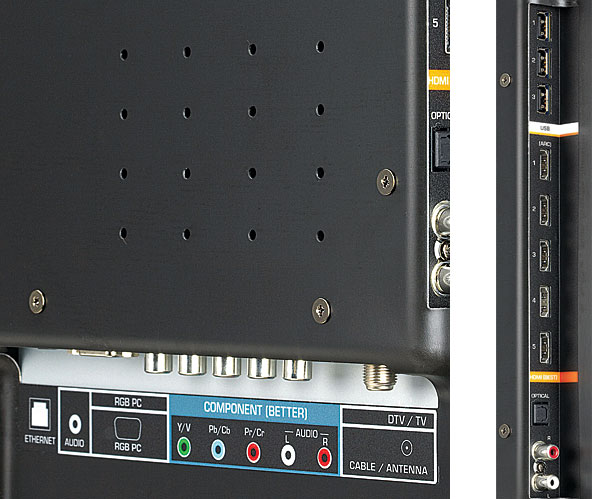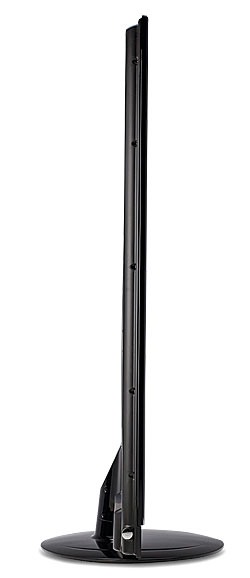Vizio XVT3D650SV 3D LED LCD HDTV Page 2
The set does not currently display 24-frame-per-second material directly (or at a direct multiple of 24 fps). Instead, it first converts it to 60 Hz by adding 3:2 pulldown. According to Vizio, a firmware update is coming that will eliminate this conversion by providing 5:5 pulldown for 24-fps sources. It may even be available by the time you read this. You can download the firmware to sets already in the field, and it will download automatically if the set is connected to the Internet. No hardware changes will be required.

A so-called Adaptive Luma control offers five settings, includ- ing Off. The Low setting added a subtle degree of punch to the picture that some viewers might like (higher settings look progres- sively more garish). I felt that the XVT3D650SV’s picture looked best on the widest range of source material with this feature off.
Smart Dimming is Vizio’s name for the set’s active LED lighting. The Vizio XVT553SV we reviewed in the December 2010 issue of Home Theater had 120 individually dimmable zones of LEDs arrayed behind its screen. In contrast, the XVT3D650SV employs 32 zones of dynamic edge lighting that modulate automatically as the source requires to provide any needed illumination from complete black to full white.
A PiP/PoP feature can display two images simultaneously. For the feature to work, one of these must be sourced via an HDMI connection.
Streaming Features
Vizio refers to its Internet features as Vizio Internet Apps, or V.I.A. You can access them
via a wired or wireless connec-
tion to your home network (no additional wireless dongle is required). As with the Internet features that other manufacturers offer, the available sites are limited to those that Vizio has part-
nered with. These currently include Hulu Plus, Netflix, Amazon Video on Demand, Wiki TV Encyclopedia, eBay, Pandora Internet Radio, Twitter, VUDU HD Movies, and Yahoo, among others. Surprisingly, YouTube hasn’t yet been brought into the Vizio corral.
We’re restricted in our testing of streamed video performance by the 2.8-megabit-per-second limi- tation of our studio’s wired net- work, well short of the 6-mb/sec recommended for better quality HD. I blame this and the source material, not the TV, for streamed images that ranged from only slightly better than SD to dismal. Vizio says the set will deliver near-Blu-ray quality with a VUDU HDX stream and appropriate connection, though remember that a 65-inch screen can be mercilessly revealing of flaws.
3D Features
At around $20 to $25 per pair, passive glasses are lighter, more comfortable, and (of course) far cheaper than the active shutter variety used with all of the 3D
sets we’ve reviewed so far. Vizio includes four pair with the XVT3D650SV. Two of them are Vizio’s version with slightly curved lenses, while the other two are a more basic design with flat lenses. If you plan to wear them over your regular glasses, the latter work better. LG has shown clip-on passive glasses, and pre-
scription passive glasses might also be possible. (For additional details on how the passive-glasses technique works compared to
the active variety, see “A Passive Approach” on page 16.)
 When it senses a 3D source, the XVT3D650SV flashes a message asking if you want to watch it in 3D. If you choose Yes and then OK, the Blu-ray will play back in 3D automatically.
When it senses a 3D source, the XVT3D650SV flashes a message asking if you want to watch it in 3D. If you choose Yes and then OK, the Blu-ray will play back in 3D automatically.
When you select 3D, the set defaults to its single 3D Picture Mode, which locks out a number of otherwise available picture controls. These include Smooth Motion, Real Cinema, Noise Reduction, Adaptive Luma, Film Mode, Smart Dimming, Ambient Light Sensor, and, most peculiarly, Brightness and Contrast.
I also found it odd that if you switch back from 3D to 2D while a 3D source is playing, the con- trols and settings remain locked in the 3D mode. The only way I found to return to the fully adjustable picture modes was to stop the player, start the disc over from the beginning, and select No when asked if you want to play back the disc in 3D. Similarly, if you fail to choose Yes when you first start a 3D disc before the 2D-or-3D selection menu times out, the playback will begin in 2D. The only way to subsequently switch it to 3D is to start the disc over from the beginning.
If the 3D is from a source that uses a different format—SBS (side-by-side), TB (top/bottom), or Sensio 3D—you can select the appropriate format from the 3D menu. There is no 2D-to-3D conversion mode.
2D Screening
Apart from failing our 2:2 HD cadence check, which is typical
of many sets we review, the Vizio passed all of our usual video processing tests. This included good upconversion
of standard-resolution images (not shown in the Video Test Bench table).








































